ISSN ONLINE(2319-8753)PRINT(2347-6710)
ISSN ONLINE(2319-8753)PRINT(2347-6710)
Nisha Rajan1, R.Subramanian2, L.Sangeetha Priya3
|
| Related article at Pubmed, Scholar Google |
Visit for more related articles at International Journal of Innovative Research in Science, Engineering and Technology
In this paper, analyzing the operation of a Permanent Magnet Synchronous Generator (PMSG) based stand alone wind power system with Sensorless Maximum Power Point Tracking (MPPT) and a system for storing energy during wind speed and load variations. In standalone system, power, balance and power quality require the energy storage system. In conventional systems, MPPT depends on wind turbine parameters such as wind speed measurement and turbine generator speed. The proposed wind turbine and energy storage system supplies and delivers the power absorbed by the connected loads. Thus the resulting system has low cost and higher reliability. In order to obtain the maximum power point tracking, the duty cycle of DC-DC boost converter switch controlled by the measurement of DC current and DC voltage. Initially, the complete representation of entire system consists of PMSG, the boost converter and the storage system is achieved. Simulation results investigate the good performance of the proposed approach with the help of MATLAB/SIMULINK.
Index terms |
| Energy Storage, Sensorless MPPT, Permanent Magnet Synchronous Generators, and Wind Energy Conversion System |
INTRODUCTION |
| With ever increasing concern on energy matters, the development of renewable energy sources such as wind, solar and hydropower plant [1], [2], [3] for electricity generation is gaining more attention. Considering the different renewable energy sources, the wind power generation is the most hastily rising energy sources. Whatever power generators do in the classical power system, similar function played by the group of microgrids connected through power and data exchange highway [4]. |
| Renewable energy sources are more attractive due to the high flexibility of the microgrid and easy combination [5], [6]. Wind energy is easily controlled. The maintenance required by the turbine generator is tolerable and no fuel cost. Hence wind energy conversion systems are the most important one for supplying electricity in standalone systems. In order to implement electromechanical conversion and control, many electrical machines can be used which describes several advantages and disadvantages [7], [8]. In case of small scale wind power system, the major subject of much research is the study about permanent magnet synchronous generator (PMSG). Permanent magnet synchronous generators are most widely used in small power wind systems. Due to its high power density and small size, it is used in low power wind energy applications. The major benefit of PMSG is the property of self excitation, which permits an operation at a high power factor and high efficiency. Diode rectifier could be used at the generator terminal because of that no excitation current is necessary. The main concept used in this paper is PMSG linked by a diode rectifier and a boost converter to the DC link for small and medium power ranges [9],[10],[11]. The use of an energy storage device such as a battery can extensively improve the consistency of a small stand alone wind system due to the high flexible nature of the wind. The consistency of the power supplied to the load can maximized by integrating right energy storage system in combination with a wind generator and that also removes the fluctuations [12], [13]. To expand the wind energy converted into electricity, the wind power converter may be operated in the autonomous system. The dissimilarity between the wind power generation and utilization of operator being directed to or supplied by the battery energy storage device linked via the power electronic interface [2]. The lead-acid battery has many merits of low price, high unit voltage, stable performance and a wide range of operating temperature. So they are the main energy storage technology [14], [15] and as key components in the advancement of the standalone wind energy system [16], [17]. |
II SYSTEM DESCRIPTION |
| This paper used 50kw wind turbine furnished with following; 1)A direct driven PMSG;2) An ac/dc converter(diode rectifier bridge + boost converter) for tracking the maximum power in sensorless approach;3) A LAB storage device;4)An inverter;5)A transformer and 6) resistive load. The proposed standalone wind power system provides three phase load at 440V/50Hz. The wind energy is reformed into the mechanical rotational energy of the wind turbine rotor. A wind turbine cannot extract the full power from wind. |
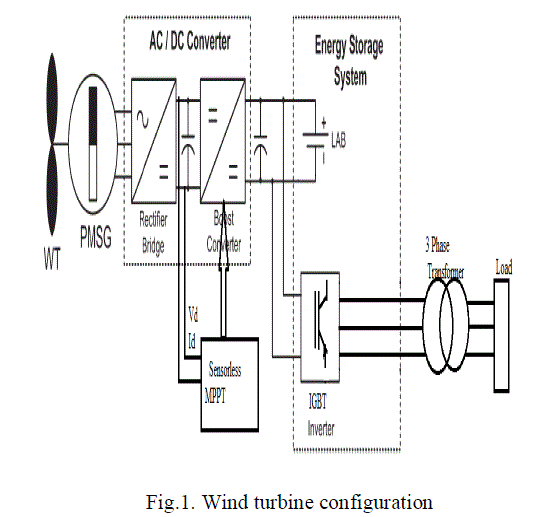 |
| The wind turbine rotor is linked to the wind generator converts the mechanical energy into electrical energy. An ac/dc converter converts the generator’s ac voltage into dc voltage. The similarity of the generator’s ac voltage to the dc voltage is done by rectifier, during which boost converter supplies the required level of constant dc voltage. The dc output voltage is fed to the battery bank and through an inverter further to the load. For different wind speeds, the voltage should be staying constant. When the wind speed is too high, the excess power provided is kept in the battery. When the wind speed is low, the generator connected with the battery bank, can supplies sufficient energy to the loads. During high speed, the turbine control system stops the energy production. When the battery is fully charged, the same protection is activated and energy production exceeds consumption. During low speeds, load shedding keep the frequency at rated value. The dc loads are provided directly from the dc circuit. The battery storage system consists of a LAB and a full-bridge singlephase inverter that converts the battery dc voltage to ac voltage. Furthermore, this voltage inserted to a three phase transformer, which boost up the voltage to 440V. The power transfer controlled by the inverter. |
| A. Modeling of PMSG |
| In the two-phase synchronous reference frame is used to derive the dynamic model of PMSG in which the d axis is 900 behind the q axis with respect to the direction of rotation. The electrical model of PMSG in the synchronous reference frame is given by (1) [18] |
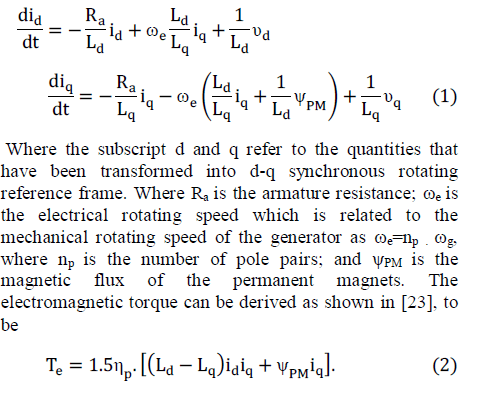 |
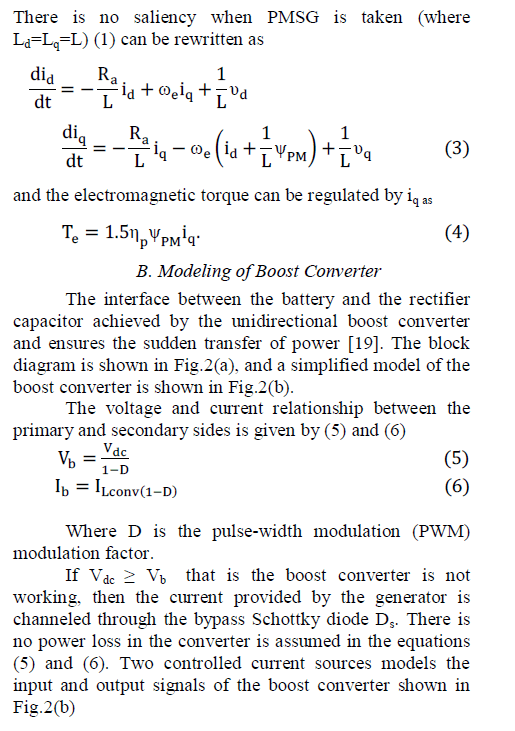 |
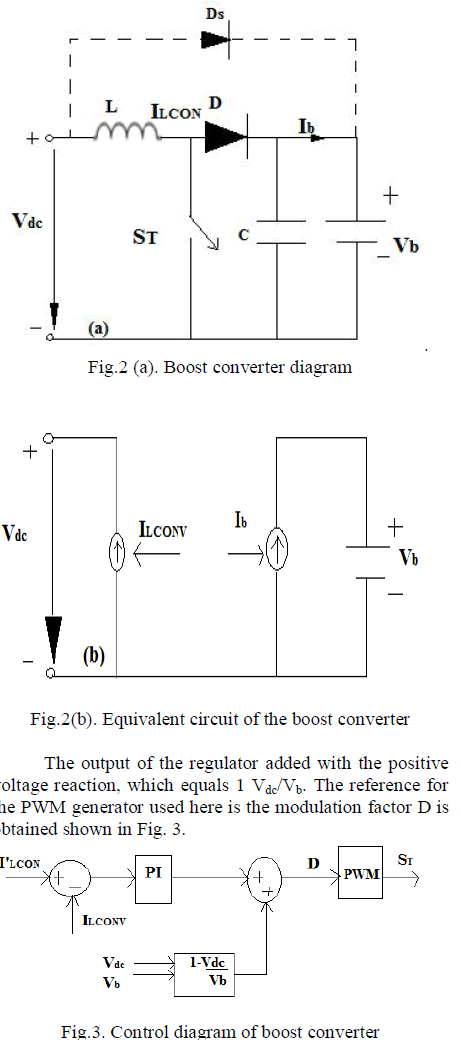 |
| C. Sensorless MPPT In this paper, by measuring the DC voltage and current of the uncontrolled rectifier the maximum power point tracking from the wind turbine. By these values, the power can be easily calculated. Comparison between the current and previous values of DC voltage by using suitable delay time can be done. In order to control the value of duty cycle for the DC-DC boost converter, the MPP algorithm needs to sense the power and the sign of the change in DC voltage[20]. Relation between mechanical power and DC voltage as shown in Fig.4. |
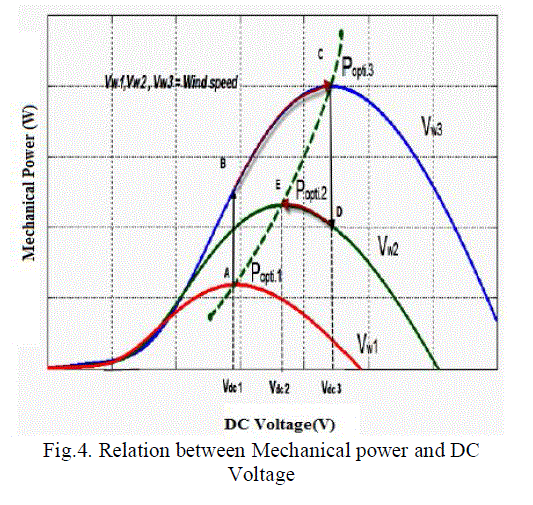 |
| The algorithm of MPPT includes several steps, which can be reduced as follows: 1).The value of DC current and DC voltage is measured at the uncontrolled rectifier terminals. 2).The value of the DC power from DC current and DC voltage values calculated. 3).The value of duty cycle (D) is increased or decreased by a certain perturbation value (ΔD). 4).The sign of (ΔP) and the sign of (ΔVd) are calculated. 5).The duty cycle of DC-DC boost converter can be changed, where there is a relation between duty cycle, rotor speed and DC voltage. |
| 6).To find the maximum operating point repeats the steps 4-5. To get the value of dutycycle inorder to achieve MPPT at any value of the wind speed to the cut out, the steps of MPT technique algorithm indicated in Fig.5. |
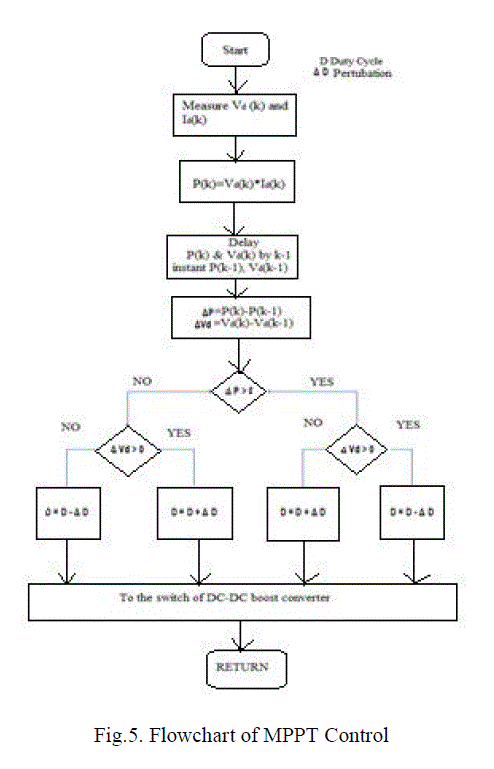 |
| provide the desired value of the inverter battery voltage, the energy storage system is consists of a singlephase MOSFET inverter and a bank of LABs 120 V each connected in series. When the wind speed is too low, the LAB is able to supplement the power provided to the by the wind turbine. The equivalent circuit model of the LAB includes a controlled voltage source (Eb), linked in series with the internal resistance ( Rint) and the battery voltage (Vb). It is known that the controlled voltage source depends on the charging state, battery type, and temperature and expressed by the following relationship: |
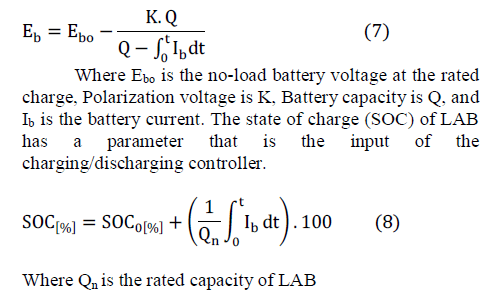 |
III. SIMULATION RESULTS AND DISCUSSION |
| In this system model we get the output of 3ph AC voltage and the corresponding current. Hence the system is operating under the generation by the permanent magnet synchronous generator PMSG. The proposed system has been modeled and simulated using the Matlab/Simulink environment. The output voltage of permanent magnet synchronous generator connected to wind turbine produce electrical energy shown in Fig.6. Generator AC voltage getting is 300V.This is connected to diode rectifier, boost converter and load. The output of boost converter as shown in Fig.7. is constant dc voltage. Boost converter variable dc voltage to constant dc voltage to constant dc voltage. This is the state of charge of battery as shown in Fig.8. State of charge is capacity of battery which can hold. |
| Battery used here is lead acid battery has many advantages. Lead acid battery output voltage is shown in Fig.9. Battery output getting is 450V. The output voltage is three phase AC voltage of 615V is shown in Fig.10. Output current of load as shown in Fig.11. Load used here is a three phase RLC load. |
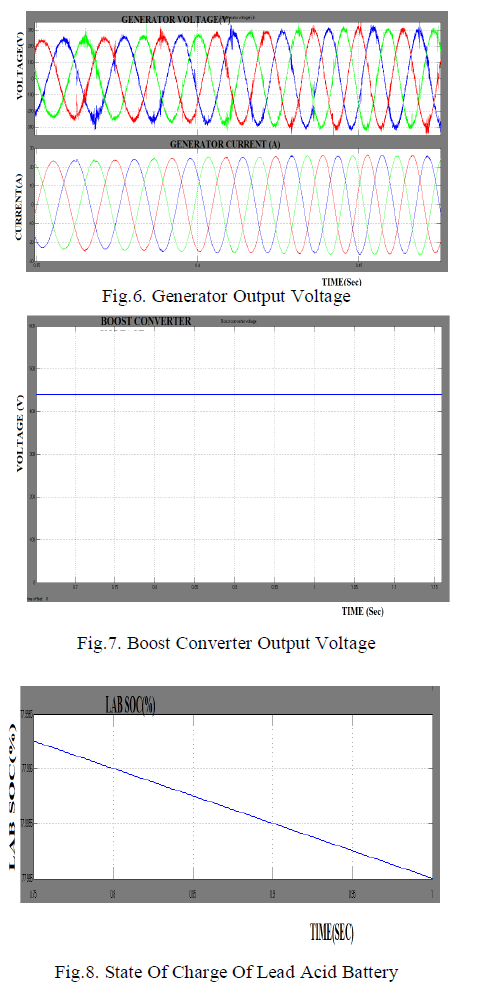 |
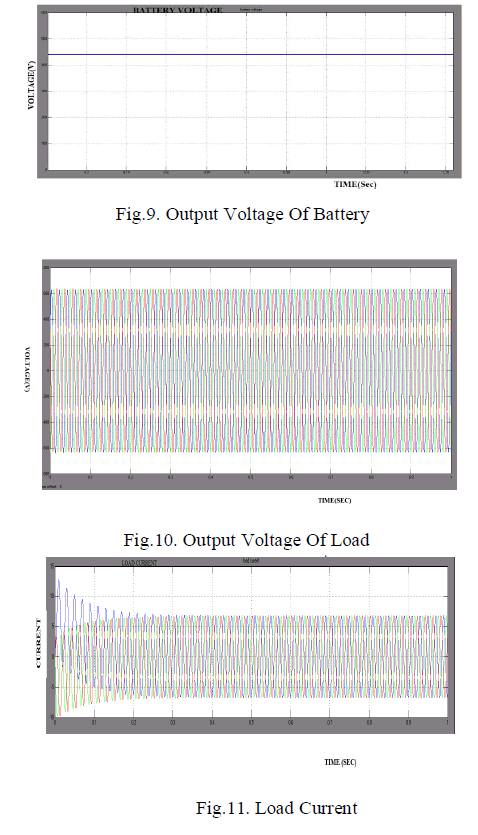 |
IV. CONCLUSION |
| In the proposed system, standalone PMSG with sensorless MPPT includes an associated energy storage system, with the role to stabilize the output voltage. The main original contributions of this paper are the following: 1) the development of sensorless approach in MPPT 2) battery SOC monitoring, with optimal conditions for battery charging. The sensorless approach in MPPT which controls the power electronic interface will ensure a maximum extraction of energy from available wind. Sensorless approaches reduce cost and increase reliability and performances of the systems. The LAB always ensures the safe supply of the loads (households), regardless of the problems caused by wind speed or load variations, by switching between the charging and the discharging modes. The proposed system can effectively provide reliable and good quality power to the customers in the autonomous power system. In this system the operation of standalone PMSG based wind energy system with sensorless MPPT. The simulation was carried out on MATLAB (r2013a) in order to analyze the control structure for three phase standalone wind-based energy sources. |
References |
|